
Overview: While reading the story "Seven Fat Cats", students will listen and match the sounds (rhyming, beginning, ending, and vowel.)
- Subject:
- English Language Arts
- Speaking and Listening
- Material Type:
- Lesson Plan
- Date Added:
- 05/12/2021

Overview: While reading the story "Seven Fat Cats", students will listen and match the sounds (rhyming, beginning, ending, and vowel.)

In this unit, students read a collection of texts focused on building an understanding of what it means to be a good friend. This unit, in connection with beginning of the year culture-building activities, will set a strong foundation for building social-emotional awareness within students as they navigate making new friendships within the classroom. This unit will also serve as the launch unit of the year-long theme, what it means to be a good person within a community. Over the course of the year, students will deepen their understanding of what it means to be a good person and grow up in different communities, part of which involves being a good friend.

In this unit, students learn about the seven continents and what makes each continent unique. A large part of the 1st grade English Language Arts curriculum is focused on communities and understanding communities around the world. In order to understand the differences between communities around the world, students need to understand what the world is, identify the different continents, and explain some of the differences between continents. Students will use the facts learned in this unit to deeply connect with the characters and information they learn in later units.

In this science-based unit, students begin their exploration of animals and animal adaptations. Using next-generation science standards as a guide, students explore three main topics: how different animals use their body parts and senses in different ways in order to survive, the ways in which the behavior of different animal parents and offspring help the offspring survive, and the similarities and differences among individual animals of the same kind. This unit is part of a larger progression on understanding animals and the animal kingdom. In kindergarten, students learn about how animals meet their basic needs for survival and how that varies depending on the season. In 2nd grade, students learn about different habitats and how animals in the habitat rely on the environment for survival. Then in 3rd grade, students study animal adaptations and the different ways animals adapt in order to survive, especially when threatened by environmental changes. It is our hope that this unit, in combination with others in the sequence, will help students develop a deeper understanding of the animal kingdom and life science.
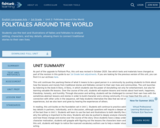
This unit continues the yearlong theme of what it means to be a good person in a community by pushing students to think about how the lessons and morals from traditional stories and folktales connect to their own lives and communities. The unit launches by listening to the book A Story, A Story, in which students see the power of storytelling not only for entertainment, but also for learning valuable life lessons. Over the course of the unit, students will explore lessons and morals about hard work, happiness, friendship, honesty, and humility. Through discussion and writing, students will be challenged to connect their own lives with the sometimes-abstract lessons and stories in order to build character and a strong community. It is our hope that this unit, in connection with other units in the sequence, will help students internalize the idea that we not only learn from our own experiences, but we also learn and grow by hearing the experiences of others.

In this biography unit, students read and learn about a diverse assortment of artists and musicians. By reading a wide variety of biographies, students will be challenged to think about where people get their inspiration, and how a person’s decisions and actions can change his or her life, especially when facing instances of prejudice and discrimination. Students will also be challenged to think about the ways in which a person can be influential and how reading about other people’s lives can help them in their own lives. It is our hope that this unit will open students’ eyes to different life paths and passions, particularly those in the arts.

The goal of this unit is to help students understand that families come in all different shapes and sizes, and that no matter what a family looks like, all families love and care for one another. The world we live in is increasingly diverse, especially within family structures. As students are building their own identities, it is important for students to see windows into their own lives so that they can develop healthy identities while also seeing windows into other lives so that they can embrace differences. Over the course of the unit, students will read stories that highlight a wide range of families and experiences, some of which may not be present in your school community. Ensuring that students see a wide range of families and experiences is crucial for helping students make sense of the world around them.

This unit is focused on two classic fairy tales: The Three Little Pigs and Little Red Riding Hood. With each fairy tale, students are first exposed to a classic version, familiarizing themselves with the basic plot and lessons. Then students explore the ways authors change setting, characters, and plot while still maintaining the overall essence of the classic story. Some of the changes the authors make reflect the nuances of different cultures and environments, while others are made for entertainment and humor. Either way, students will explore the idea that different authors can use their own perspective and culture to shape the stories they write or retell. By reading multiple versions of the same classic fairy tale, students will also be able to grapple with the bigger lessons of each tale—the importance of not talking to strangers and the importance of respecting others’ property and privacy. Over the course of the unit, students will be challenged to think about how each of these unique themes is portrayed and how in each different version of the fairy tale the characters may learn the lesson in slightly different ways. It is our hope that this unit, in connection with others in the sequence, will help students see the power of storytelling and how simple stories can be changed and improved based on an author’s ideas and preferences.
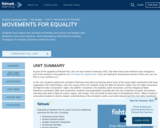
In this unit, students explore the concepts of fairness and justice by learning about many of the equal rights movements that have happened in the United States. Over the course of the unit, students study the fight for women’s rights, the civil rights movement, the fight for labor and workers’ rights, the LGBTQ+ movement, the disability rights movement, and the Indigenous Water Protectors movement. With each movement, students read biographies of people who are not in positions of power and analyze how they were able to fight for justice, equity, and change. This unit builds on work done in Kindergarten Unit 6, “What is Justice?” and pushes students to build a deeper understanding of discrimination, justice, and action beyond just the civil rights movement.

In this unit, students explore ancient Egypt. Over the course of the unit, students learn and explore different characteristics of ancient Egypt and what the ancient Egyptians valued. Through learning about the daily routines, structures, and rituals of ancient Egypt, students will be challenged to draw conclusions about what the civilization valued and how those values compare to society today. Students will also learn about the role that mummies and pyramids played in ancient Egyptian society and why archeologists and scientists have been intrigued by them ever since. It is our hope that this unit, in conjunction with the others in the sequence, will help students understand and appreciate early civilizations that have had a lasting impact on the world.

In this unit, students explore the power of books and reading. In the first part of the unit, students experience the joy that books and reading bring to people's lives, and learn about some of the different ways people access books, especially in places where books are hard to get. In the second part of the unit, students learn about a range of barriers people have faced when trying to learn how to read, both in the United States and around the world, and build an understanding of the steps people have taken individually and as part of a community to overcome the barriers. Students will discover that not all people have had equal access to education and that in many places, past and present, receiving a high-quality education has not been an easy feat. It is our hope that this unit will help open students' eyes to injustices connected with educational access and will inspire students to take action to help members of their community get access to books or education.

concepts found in Eureka Math- 1st grade
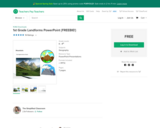
Teach your students about 6 different landforms with this PowerPoint presentation. It includes the definition and pictures of the following landforms: mountain, plain, valley, desert, canyon, and island. *************************************************************************** Please leave FEED...

Overview: In this lesson, students will particpate in three separate learning activities. These activities are each made to help improve the students' knowledge of creating real-world problems to represent an addition and a subraction equation within 20. At the end of the lesson, there is an assessment in order to check the effectivenss of the learning activities

This is an example of lessons that are available in my 1st Grade Michigan Social Studies lesson series. To check out units and bundles, follow the links below!1st Grade Social Studies YEAR LONG BundleUnit 1 - My Family & MeUnit 2 - EconomicsUnit 3 - Where I AmUnit 4 - Learning About the PastUnit...

Mini lesson Google Slides. Learning Target: Producers and Consumers...

Slidedeck for use with K12 School Administrators at Calhoun ISD. Includes sections on: OER in Michigan, OER Basics, Common OER Myths, and activities tied to the OER for Administrators Playbook.
Remix of several other slidedecks, along with original work.
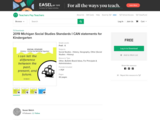
These colorful "I CAN" statements are written for the newly updated 2019 Michigan Social Studies standards. Display in your room to increase visibility and make your student learning goals clearly visible for students, parents, and administrators. Please contact me for multiple use purchases as th...

In this activity, students determine their own eyesight and calculate what a good average eyesight value for the class would be. Students learn about technologies to enhance eyesight and how engineers play an important role in the development of these technologies.
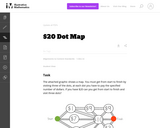
This problem helps students practice adding three numbers whose sum are 20 or less.